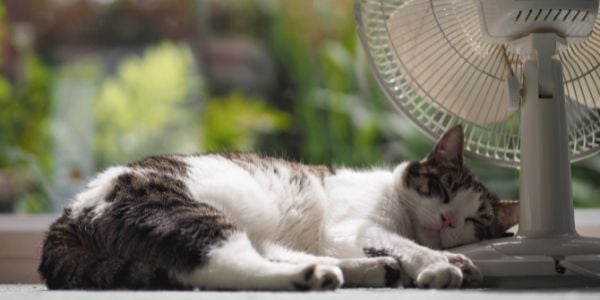 Most cats can regulate their body temperature well on their own so that they don’t overheat.
Most cats can regulate their body temperature well on their own so that they don’t overheat.
But when the temperature outside or indoors is soaring, they may struggle to stay cool.
These 13 tips will help you keep your cat from overheating this summer!
If you're worried your cat is already overheated, check out the symptoms of heatstroke below, and apply first aid right away. And don't delay in getting them to a veterinarian.
Steps You Can Take to Protect Your Cat from Heat-Related Illness
We have all heard the saying, “An ounce of prevention is worth a pound of cure.” This saying is very accurate in helping cats stay cool and prevent overheating during hot weather. By keeping your cat happy, healthy, and ‘chill’ with these tips, you both will have an enjoyable summer.
Hydration
- Ensure that your cat always has easy access to plenty of fresh, cool drinking water. Add extra bowls of water around your home. To help keep the water cool, use refrigerated water or place an ice cube in the water each time you change it.
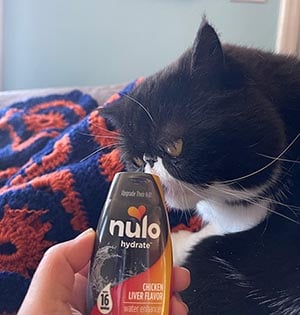 Add some tuna water, low-sodium chicken broth (without onions or garlic), or chicken-liver-flavored Nulo to your cat’s water dishes to encourage more drinking.
Add some tuna water, low-sodium chicken broth (without onions or garlic), or chicken-liver-flavored Nulo to your cat’s water dishes to encourage more drinking.- Try using a water fountain instead of a bowl since it encourages cats to drink more. Cats tend to like moving water.
- If you don’t already feed canned food, consider adding some to your cat’s meals during the warmer days of the year to help with their hydration.
Another reason hydration is important is that cats tend to groom themselves more when they're warm.
The saliva left on their fur evaporates, helping them stay cool. This works much the same as sweating does for us. Cats don't sweat from their skin. They will sweat a bit from the paw pads, though.
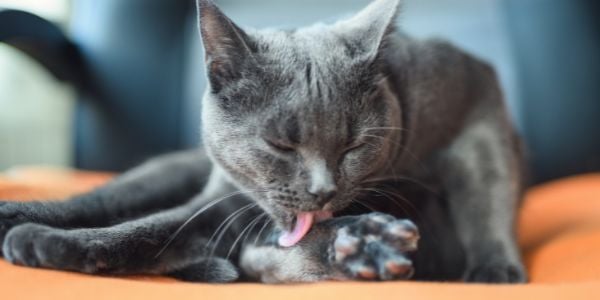
Grooming & Fur
- Interaction and observation are important to monitor how your cat is doing. But combine it with a bit of prevention by gently rubbing them with a cool (not cold), damp washcloth. This can help keep them cool.
- Grooming is essential to keeping cats cool. Routinely brush them to remove tangles, matted fur, and any undercoat so that air can freely flow to their skin and help keep them cooler. Matted or tangled fur can cause heat to be trapped against the skin and prevent cooling.
- Trimming your cat's fur is not always a good idea because their skin is thin and fragile, so it can be easily cut. Their fur helps protect them from sunburn, and without their fur, their skin is more vulnerable to environmental hazards. Speak to your veterinarian about whether or not you should have your cat professionally trimmed, especially if they have long, tangled, or matted hair.
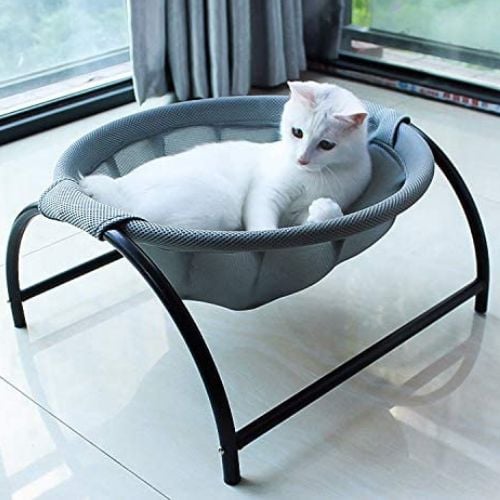
Bedding
- Raising up your cat’s bed with legs will allow for better ventilation under the bed. An elevated hammock like this one works well, as does a breathable, mesh-like bed like the one in the photo above.
- Create a "cooling station." When it's hot, cats love to lie on cool surfaces. A cooling mat like the one below works well, as it's pressure-activated and doesn't need to go in the freezer or be plugged in.
Alternatively, you can freeze a flat pet-safe ice pack, wrap it in a towel, and place it in your cat’s preferred snoozing location. Never allow your cat to lie on an ice pack that directly touches their skin.
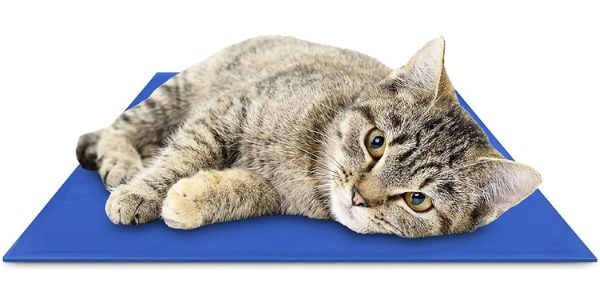
Cooling the Indoors
- Show them you are their "biggest fan" by plugging in a small, quiet box fan to create a gentle breeze. For added cooling benefits, you can place it near air conditioning or put a frozen water bottle in front of it.
- To help keep your home cooler, close curtains and blinds during the day. This also helps prevent napping spots in places that get a lot of hot direct sunlight through the window.
Cooling the Outdoors
- If your cat spends any time outdoors, make sure not to let them out during the hottest parts of the day. If you take your cat for walks, try to do so earlier in the morning or later in the evening.
- If you have a cat that insists on being outdoors in the heat, provide safe cooling spots for them. Hang canopies to create shaded areas, or set up cooling pens like the one below. These are great for large catios as well.
NOTE: Always be sure to check for your cat in sheds or garages before closing them up. The last thing you want to do is trap them in on a hot day.
Predisposing Factors for Heatstroke
There are some breed, physical, and medical factors that can increase the risk of a cat having issues with the heat. These include:
- Brachycephalic breeds (flat-faced): Persians, Himalayans, Exotic Shorthairs, Scottish Folds, and snub-nosed mixes of these breeds
- Cats with long and thick fur: Maine Coons, Norwegian Forest, Birman, Turkish Angora, Ragdoll
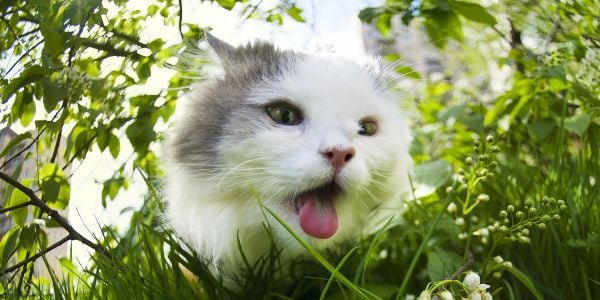
- Excess weight: Fat cells serve as increased insulation that, while beneficial in the cold, has the opposite effect when temperatures rise. Additionally, overweight cats generate more heat from even mild exercise.
- Heart issues such as dilated cardiomyopathy or hypertrophic cardiomyopathy
- Neurological issues such as seizures
- Respiratory issues such as asthma or bronchitis.
Note: If your cat has a crusty, runny nose, work with your veterinarian to treat the underlying cause (e.g., a respiratory infection) since it can increase the risk of heatstroke.
Be sure to pay attention to nursing care, including keeping your cat’s nostrils clean and clear by frequently wiping with a damp tissue, gauze, or pet wipes, like Furbliss. - Age: very young or old
- Hyperthyroidism
If your cat has a predisposing medical condition (e.g., heart disease, feline asthma), work with your veterinarian or an appropriate veterinary specialist to achieve a cure or the best management. Conditions like these make it harder for cats to stay cool because they can impair your cat's breathing and ability to lose heat.
Additionally, when a cat's breathing is impaired, they become more stressed, which increases their body temperature and can worsen the symptoms of heatstroke. Stressed cats often breathe through their mouth (pant), which can make recognizing the symptoms of heatstroke more difficult.
Recognizing the Signs of Heatstroke in Your Cat
Unfortunately, cats can be very good at hiding health problems. If you notice your cat exhibiting one or more of the following symptoms, it could be an indication that they are suffering from heatstroke or some other condition that warrants medical evaluation.
- Panting (there are various reasons cats pant)
- Sweaty feet (cats sweat through glands in their paws). If you are noticing more than normal "wet" paw prints, your cat may be hotter than you think and dehydrated.
- Disorientation
- Vomiting
- Restlessness
- Lethargy
- Drooling or thick/sticky saliva
- Bright red tongue, mouth
- Rectal temperature above 105ºF (normal temperature should be 101.5 ºF +/- 1)
Emergency first aid must be started immediately at home, the moment you suspect your cat is suffering from heatstroke. Then it is critical to take your cat for veterinary care. For more detail, see our heatstroke article.
Some Emergency First-Aid Steps You Can Take at Home
Heatstroke is an emergency – always see a vet. Start with these first-aid steps, but even if your cat looks like they may be recovering or you suspect they might have heatstroke, they should always be checked by a veterinarian.
- It is critical to immediately remove your cat from the heat into a cool and shaded area or an air-conditioned location.
- Using cool or tepid water, thoroughly and continuously wet your cat’s fur. DO NOT use ice or cold water since this can make the situation worse.
- Keep removing excess water by gently ‘petting’ it off as it absorbs excess heat.
- Place a fan to gently blow over their body to help aid in cooling.
- Regularly take their temperature using your thermometer from your first-aid kit. Stop cooling when their temperature reaches 102.5°F to 103°F
- Take your cat to the veterinarian for evaluation, even if they appear to be recovering.
For the most part, cats adapt well to heat, but if you follow some of the tips in this article, you'll be assuring them a comfortable and safe summer.




